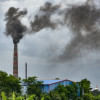Don't let closed brick kilns pop up again

Although we are delighted to learn about the 209 illegal brick kilns that have been shut down in recent months—as part of a special action plan of the Ministry of Environment, Forest and Climate Change—we remain concerned about the effectiveness of such measures. Time and again, such kilns were closed, and their spaces freed, only for these establishments to re-emerge after a while. According to a report by Prothom Alo, the Department of Environment shut down about 1,000 brick kilns in the last four years, but 75 percent of those have resumed operations. The question is: Why are shuttered brick kilns reappearing? And how can the relevant agencies put an end to this practice?
Reportedly, out of the estimated 7,086 brick kilns operating in the country, only 2,581 have environmental clearance. This means that around 4,505 brick kilns have been operating illegally, taking a massive toll not only on the environment but also the lives of local communities. In Lalmonirhat and Kurigram, for example, 132 out of a total of 173 brick kilns are running illegally, without any valid license or legal papers. Bricks in such kilns are usually made with topsoil from cultivable lands, affecting their fertility. Besides, toxic fumes coming out of the kilns also affect the production of crops, fruits and vegetables. Local farmers, either forced or tempted into selling topsoil to owners of brick kilns, cannot do anything about the long-term damage because of the latter's influence.
Against this backdrop, it is heartening to see the progression of the ministry's 100-day work plan launched in January to tackle pollution comprehensively. The plan focuses on strengthening relevant institutions, revising laws and policies, controlling pollution, conserving biodiversity, and addressing climate change. While the new minister's dedication to reducing air pollution from brick kilns is commendable, the continued re-emergence of dangerous kilns raises concerns about the plan's long-term efficacy.
Given the persistence of these establishments, it may be prudent for the government to consider stricter penalties and explore sustainable alternatives, such as recycled plastic bricks. This approach could address both pollution and waste management simultaneously, potentially offering a more effective solution to the problem. Only through such decisive and sustained actions can we hope to achieve a pollution-free environment.


 For all latest news, follow The Daily Star's Google News channel.
For all latest news, follow The Daily Star's Google News channel. 










Comments